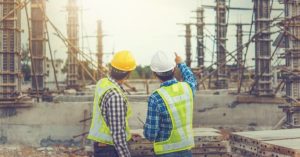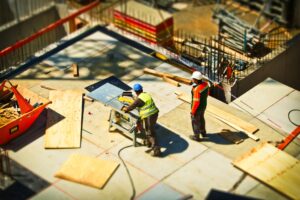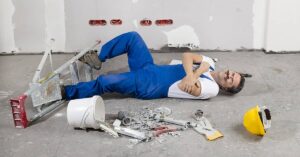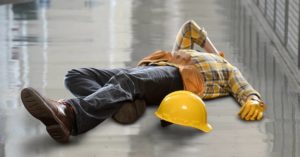
Construction work is dangerous. Any job on a construction site comes with a significant risk of serious injury.
If you have been injured on the job, you are likely entitled to workers’ compensation benefits. Depending on the circumstances, you may be able to bring one or more third-party claims as well.
Prompt investigation is essential for identifying what caused your injuries and who may be at fault. The construction accident attorneys at the Whitley Law Firm can evaluate your legal options and pursue the full benefits and other compensation you deserve.
What Are the Main Risks Commonly Found on a Construction Site?
Dangerous conditions are everywhere on the typical construction site. Some hazards lead to cuts, bumps, and bruises, while others can result in serious injuries or even death.
Construction workers need to be aware of the following safety risks and take steps to prevent accidents:
1. Working at Heights
All jobs that take construction workers above the ground can result in accidental falls. Falls from any height – whether a few feet off the ground or multiple stories in the air – can result in catastrophic and potentially fatal injuries.
Some of the most common causes of falls on construction sites include:
- Improper use of ladders
- Failure to maintain ladders
- Defective or improperly built scaffolding
- Errors in using aerial lifts, bucket trucks, and cherry pickers
- Falls from cranes and other heavy equipment
- Unguarded roof and building edges
Failure to provide fall protection is the most frequently cited violation of OSHA safety standards. Even the most experienced construction workers can be injured or killed if they are not provided with adequate, functional equipment to prevent and arrest falls.
2. Slipping and Tripping Hazards
Workers and supervisors alike have a responsibility to minimize potential slipping and tripping hazards on the job site. Spills should be cleaned up promptly, power cords should be moved out of walkways, and materials and debris should be removed to reduce the risk of falls.
Some areas of the job site present additional risks for slips, trips, and falls. These include stairways, uneven terrain, and ground where heavy machinery and vehicles frequently travel.
Injuries in a slip and fall accident can be serious. You may be unable to work if you suffer a fracture or sprain in a fall, while a head injury could permanently alter the course of your life.
3. Moving Equipment and Other Objects
Conditions on a construction site change from moment to moment. Workers and machines move from place to place constantly. A moment’s carelessness, unfortunately, can cause a collision between workers and machines that leaves the worker injured, caught under the machine, or pinned between the equipment and a barrier.
Heavy vehicles are not the only cause of these events (known broadly as “struck-by accidents”). Objects falling from heights – such as tools, materials, and more – can hit workers below and cause serious injuries.
4. Dangerous Materials
Construction workers are at risk for a number of occupational diseases as a result of toxic chemicals and materials on the job. Exposure can take many different forms, from inhalation of dust and fumes to skin absorption.
Some of the most dangerous substances commonly found on construction sites include:
- Silica: Inhaling crystalline silica can damage the lungs and kidneys. In addition to increasing the risk of lung cancer and chronic obstructive pulmonary disorder, workers who breathe silica dust may also suffer scarring of the lungs – a condition known as silicosis.
- Asbestos: The biggest risk for asbestos exposure today occurs when fibers are disturbed during construction, repairs, and demolition of old buildings. Inhaling asbestos fibers accounts for the vast majority of mesothelioma cases. Mesothelioma is a cancer that can affect the lining around the lungs, the heart, the abdomen, and the testicles.
- Lead: Another material commonly encountered when working on old buildings and structures, lead is associated with a wide range of toxic effects. Workers who inhale lead particles or fumes or accidentally ingest lead particulates are at risk for high blood pressure, kidney disease, and cognitive deficits. Lead exposure in adults also increases the incidence of birth defects in children.
- Diesel fumes: The immediate effects of breathing in fumes from diesel exhaust include irritation of the airway, headaches, and disorientation. Chronic exposure can lead to asthma, heart disease, and increased cancer risk.
- Industrial solvents: Solvents such as acetone, benzene, and others have a wide range of applications in construction, from adhesives and sealants to paints and stains. Construction workers are at risk for a wide range of adverse health effects from solvents via inhalation, ingestion, and skin absorption.
Mold is another common danger on construction sites. Lumber, drywall, and other materials can be perfect places for toxic mold to grow.
Personal protective equipment is essential for helping construction workers to avoid the adverse health effects associated with dangerous materials and substances on the job site. Employers are responsible for ensuring that workers have the equipment they need to do their jobs safely.
5. Electrical Current and High Voltage
Electrocution is one of the most serious injuries on a construction site. Potential causes of electrical injury in construction include:
- Inadequate grounding of electrical outlets
- Exposure to high-voltage power lines
- Damaged and defective power cords and extension cords
- Improper use of power tools, machinery, and equipment
An electric shock can lead to severe burns, cause cardiac arrest, and lead to traumatic injuries if the victim is thrown back by the force of the electrocution. These accidents often prove fatal.
6. Collapses
Some of the most devastating accidents on construction sites involve the collapse of structures and equipment. These include:
- Collapsing walls and roofs of a building under construction
- Trench collapses
- Scaffold collapses
- Crane accidents
- Malfunctioning aerial lifts
A host of factors can lead to these collapses, including errors in construction, exceeding the weight limit for temporary structures and equipment, and more. Multiple workers may be injured or killed in the event of a collapse.
7. Operating Tools and Machinery
Hand tools, power tools, and machines all carry certain risks. Construction workers commonly suffer repetitive stress injuries as a result of repeated motions and mechanical vibrations. These injuries often start with pain, tingling, and weakness in affected areas of the body, but they can become debilitating with time.
Malfunctioning tools and machinery (and/or inadequate training) can lead to catastrophic injuries. In extreme cases, workers may become stuck in operating equipment, potentially resulting in crush injuries and traumatic amputations. In combination with trench cave-ins and workers becoming trapped between equipment and fixed objects, unguarded machines are classified by OSHA as “caught in-between hazards.”
8. Loud Noise
Construction sites are inherently noisy environments. As such, employers have a responsibility to provide workers with hearing protection equipment. The required protection must be appropriate for the level of noise in the construction workplace.
Unfortunately, construction workers are not always provided with proper hearing protection or instructed how to use it appropriately. Supervisors may also fail to recognize the amount of noise generated by machines, equipment, and activities on the job site. All of these issues can cause construction workers to suffer hearing loss.
9. Handling Materials
Errors in manual lifting are one of the most common causes of injury among construction workers. Carrying too much at once, failure to lift with the legs, and other mistakes can lead to sprains, strains, and other injuries.
A back injury from improper lifting can make it difficult or even impossible for you to work. Other parts of the body may also be negatively affected, such as the wrists, elbows, and shoulders.
10. Improper Training and Safety Violations
Construction employers have a duty to ensure that workers know how to perform their jobs safely. When workers don’t have the proper training and equipment, it’s an accident waiting to happen.
Improper training can lead to serious errors when operating tools and equipment, failure to follow lockout and tagout procedures when using machines, and more. OSHA inspections (or the diligence of workers and supervisors) may reveal hazards before accidents occur. If not, however, the consequences could be catastrophic and potentially deadly.
The Whitley Advantage isn’t just one thing – it’s everything.
Contact Us Today For a FREE Confidential Case Review (800) 785-5000What Is the Greatest Hazard on a Construction Site?
By a wide margin, falls are the biggest danger on construction sites nationwide. The most recent OSHA statistics recorded 320 fatal falls in a single year, making falls the leading cause of death in the construction industry.
Proper training and equipment are essential for mitigating the risk of falls on construction sites. Far too often, however, safety becomes a secondary concern.
Have You Been Injured on a Construction Site?
Workplace injuries take an enormous toll on workers and their families. A work-related death can create immense hardship for surviving loved ones.
Many different hazards can lead to construction accidents. You may be entitled to workers’ compensation benefits, as well as have additional claims you can file against one or more negligent third parties.
The only way to know the full extent of your legal rights and options is to contact a construction accident lawyer as soon as possible. Attorneys at the Whitley Law Firm are dedicated to pursuing maximum compensation on your behalf and providing the personalized representation you deserve.
Please call the Whitley Law Firm at (919) 785-5000 to speak to a construction accident lawyer today. Our attorneys serve clients in Raleigh, Kinston, New Bern, and throughout North Carolina. It won’t cost anything to see if we can help.
Learn about what makes us unique and why we are the right firm to help you.
Contact Us Today For a FREE Confidential Case Review (800) 785-5000



